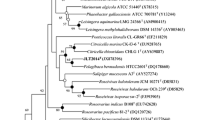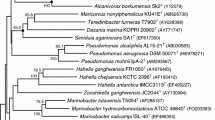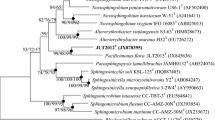Abstract
A strictly aerobic, Gram-negative, beige-pigmented, short-rod-shaped, non-motile and chemoheterotrophic bacteria, designated K2-48T was isolated from seawater collected in the Western North Pacific Ocean near Japan. Preliminary analysis based on the 16S rRNA gene sequence revealed that the novel isolate was affiliated with the family Oceanospirillaceae within the class Gammaproteobacteria and that it showed the highest sequence similarity (93.7 %) to Neptunomonas qingdaonensis P10-2-4T. The strain could be differentiated phenotypically from recognized members of the family Oceanospirillaceae. The major fatty acids of strain K2-48T were identified as summed feature 3 (C16:1 ω7c and/or iso-C15:0 2-OH) and C16:0 as defined by the MIDI system. The DNA G+C content was determined to be 43.2 mol%, the major respiratory quinone was identified as ubiquinone 9 and a polar lipid profile was present consisting of phosphatidylethanolamine, a phosphatidylglycerol and an unidentified phospolipid. On the basis of polyphasic taxonomic studies, it was concluded that strain K2-48T represents a novel genus sp. We propose the name Pelagitalea pacifica gen. nov., sp. nov. for this strain; its type strain is K2-48T (=KCCM 90119T).


Similar content being viewed by others
References
Arahal DR, Lekunberri I, González JM, Pascual J, Pujalte MJ, Pedrós-Alió C, Pinhassi J (2007) Neptuniibacter caesariensis gen. nov., sp. nov., a novel marine genome-sequenced gammaproteobacterium. Int J Syst Evol Microbiol 57:1000–1006
Bianchi A, Bianchi M (1995) Bacterial diversity and ecosystem maintenance: an overview. In: Hawksworth DL, Colwell RR (eds) Microbial diversity and ecosystem maintenance. CAB International (UNEP), Wallingford, pp 185–198
Bowditch RD, Baumann L, Baumann P (1984) Description of Oceanospirillum kriegii sp. nov. and O. jannaschii sp. nov. and assignment of two species of Alteromonas to this genus as O. commune comb. nov. and O. vagum comb. nov. Curr Microbiol 10:221–230
Chen MH, Sheu SY, Chiu TF, Chen WM (2012) Neptuniibacter halophilus sp. nov., isolated from a salt pan, and emended description of the genus Neptuniibacter. Int J Syst Evol Microbiol 62:1104–1109
Collins MD, Jones D (1981) A note on the separation of natural mixtures of bacterial ubiquinones using reverse-phase partition thin-layer chromatography and high performance liquid chromatography. J Appl Bacteriol 51:129–134
Dittmer JC, Lester RL (1964) A simple, specific spray for the detection of phospholipids on thin-layer chromoatograms. J Lipid Res 15:126–127
Espinosa E, Marco-Noales E, Gómez D, Lucas-Elío P, Ordax M, Garcias-Bonet N, Duarte CM, Sanchez-Amat A (2010) Taxonomic study of Marinomonas strains isolated from the seagrass Posidonia oceanica, with descriptions of Marinomonas balearica sp. nov. and Marinomonas pollencensis sp. nov. Int J Syst Evol Microbiol 60:93–98
Felsenstein J (1985) Confidence limits on phylogenies: an approach using the bootstrap. Evolution 39:783–791
Fitch WM (1971) Towards defining the course of evolution: minimum change for a specific tree topology. Syst Zool 20:406–416
Giovannoni SJ, Rappé M (2000) Evolution, diversity, and molecular ecology of marine prokaryotes. In: Kirchman D (ed) Microbial ecology of the Oceans. Wiley, New York, pp 47–84
González JM, Mayer F, Moran MA, Hodson RE, Whitman WB (1997) Microbulbifer hydrolyticus gen. nov., sp. nov., and Marinobacterium georgiense gen. nov., sp. nov., two marine bacteria from a lignin-rich pulp mill waste enrichment community. Int J Syst Bacteriol 47:369–376
Hedlund BP, Geiselbrecht AD, Bair TJ, Staley JT (1999) Polycyclic aromatic hydrocarbon degradation by a new marine bacterium, Neptunomonas naphthovorans gen. nov., sp. nov. Appl Environ Microbiol 65:251–259
Jung YT, Oh TK, Yoon JH (2012) Marinomonas hwangdonensis sp. nov., isolated from seawater. Int J Syst Evol Microbiol 62:2062–2067
Kersters K, Devos P, Gillis M, Swings J, Vandamme P, Stackebrandt E (2006) Introduction to the Proteobacteria. In: Dworkin M, Falkow S, Rosenberg E, Schleifer KH, Stackebrandt E (eds) The prokaryotes: a handbook on the biology of bacteria. Springer, New York, pp 3–37
Kim JM, Lee SH, Jung JY, Jeon CO (2010) Marinobacterium lutimaris sp. nov., isolated from a tidal flat. Int J Syst Evol Microbiol 60:1828–1831
Kim SJ, Park SJ, Yoon DN, Park BJ, Choi BR, Lee DH, Roh Y, Rhee SK (2009) Marinobacterium maritimum sp. nov., a marine bacterium isolated from Arctic sediment. Int J Syst Evol Microbiol 59:3030–3034
Kimura M (1983) The neutral theory of molecular evolution. Cambridge University Press, Cambridge
Komagata K, Suzuki K (1987) Lipid and cell-wall analysis in bacterial systematics. Methods Microbiol 19:161–207
Kumari P, Poddar A, Das SK (2014) Marinomonas fungiae sp. nov., isolated from the coral Fungia echinata from the Andaman Sea. Int J Syst Evol Microbiol 64:487–494
Marmur J (1961) A procedure for the isolation of deoxyribonucleic acid from micro-organisms. J Mol Biol 3:208–218
Mesbah M, Premachandran U, Whitman WB (1989) Precise measurement of the G+C content of deoxyribonucleic acid by high-performance liquid chromatography. Int J Syst Bacteriol 39:159–167
Minnikin DE, O’Donnell AG, Goodfellow M, Alderson G, Athalye M, Schaal A, Parlett JH (1984) An integrated procedure for the extraction of bacterial isoprenoid quinines and polar lipids. J Microbiol Meth 2:233–241
Miyazaki M, Nogi Y, Fujiwara Y, Kawato M, Nagahama T, Kubokawa K, Horikoshi K (2008) Amphritea japonica sp. nov. and Amphritea balenae sp. nov., isolated from the sediment adjacent to sperm whale carcasses off Kagoshima, Japan. Int J Syst Evol Microbiol 58:2815–2820
Lee HW, Shin NR, Lee J, Roh SW, Whon TW, Bae JW (2012) Neptunomonas concharum sp. nov., isolated from a dead ark clam, and emended description of the genus Neptunomonas. Int J Syst Evol Microbiol 62:2657–2661
Liu A, Zhang XY, Chen CX, Xie BB, Qin QL, Liu C, Li GW, Li H, Xu Z, Chen XL, Zhou BC, Zhang YZ (2013) Neptunomonas qingdaonensis sp. nov., isolated from intertidal sand. Int J Syst Evol Microbiol 63:1673–1677
Miyazaki M, Nogi Y, Fujiwara Y, Kawato M, Kubokawa K, Horikoshi K (2008) Neptunomonas japonica sp. nov., an Osedax japonicus symbiont-like bacterium isolated from sediment adjacent to sperm whale carcasses off Kagoshima, Japan. Int J Syst Evol Microbiol 58:866–871
Pinhassi J, Berman T (2003) Differential growth response of colony-forming alpha- and gamma-proteobacteria in dilution culture and nutrient addition experiments from Lake Kinneret (Israel), the eastern Mediterranean Sea, and the Gulf of Eilat. Appl Environ Microbiol 69:199–211
Pot B, Gillis M, Hoste B, van de Velde A, Bekaert F, Kersters K, de Ley J (1989) Intra- and inter-generic relationships of the genus Oceanospirillum. Int J Syst Bacteriol 39:23–34
Saitou N, Nei M (1987) The neighbor-joining method: a new method for reconstructing phylogenetic trees. Mol Biol Evol 4:406–425
Sasser M (1990) Identification of bacteria by gas chromatography of cellular fatty acids (MIDI technical note 101). MIDI Inc, Newark
Satomi M, Kimura B, Hamada T, Harayama S, Fujii T (2002) Phylogenetic study of the genus Oceanospirillum based on 16S rRNA and gyrB genes: emended description of the genus Oceanospirillum, description of Pseudospirillum gen. nov., Oceanobacter gen. nov. and Terasakiella gen. nov. and transfer of Oceanospirillum jannaschii and Pseudomonas stanieri to Marinobacterium as Marinobacterium jannaschii comb. nov. and Marinobacterium stanieri comb. nov. Int J Syst Evol Microbiol 52:739–747
Stackebrandt E, Murray RGE, Trüper HG (1988) Proteobacteria classis nov., a name for the phylogenetic taxon that includes the ‘‘purple bacteria and their relatives’’. Int J Syst Bacteriol 38:321–325
Tamura K, Peterson D, Petersen N, Stecher G, Nei M, Kumar S (2011) MEGA5: molecular evolutionary genetics analysis using maximum likelihood, evolutionary distance, and maximum parsimony methods. Mol Biol Evol 28:2731–2739
Thompson JD, Gibson TJ, Plewniak F, Jeanmougin F, Higgins DG (1997) The CLUSTAL_X windows interface: flexible strategies for multiple sequence alignment aided by quality analysis tools. Nucleic Acids Res 25:4876–4882
Weisburg WG, Barns SM, Pelletier DA, Lane DJ (1991) 16S ribosomal DNA amplification for phylogenetic study. J Bacteriol 173:697–703
Woese CR, Weisburg WG, Hahn CM, Paster BJ, Zablen LB, Lewis BJ, Macke TJ, Ludwig W, Stackebrandt E (1985) The phylogeny of purple bacteria: the gamma subdivision. Syst Appl Microbiol 6:25–33
Worliczek HL, Kampfer P, Rosengarten R, Tindall RBJ, Busse HJ (2007) Polar lipid and fatty acid profiles-re-vitalizing old approaches as a modern tool for the classification of mycoplasmas? Syst Appl Microbiol 30:355–370
Zhang XY, Zhang YJ, Yu Y, Li HJ, Gao ZM, Chen XL, Chen B, Zhang YZ (2010) Neptunomonas antarctica sp. nov., isolated from marine sediment. Int J Syst Evolut Microbiol 60:1958–1961
Acknowledgments
We are grateful to the officers and crews of the R/V Mirai (Japan Agency for Marine-Earth Science and Technology [JAMSTEC]) for their assistance and support in sample collection. This work was supported by a research grant from the Institute for Fermentation, Osaka, Japan.
Author information
Authors and Affiliations
Corresponding author
Electronic supplementary material
Below is the link to the electronic supplementary material.
Rights and permissions
About this article
Cite this article
Lee, H., Yoshizawa, S., Kogure, K. et al. Pelagitalea pacifica gen. nov., sp. nov., a New Marine Bacterium Isolated from Seawater. Curr Microbiol 70, 514–519 (2015). https://doi.org/10.1007/s00284-014-0750-1
Received:
Accepted:
Published:
Issue Date:
DOI: https://doi.org/10.1007/s00284-014-0750-1




